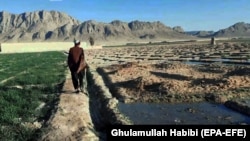On August 17, Taliban spokesperson Zabihullah Mujahid gave his first news conference following the Taliban’s takeover of Afghanistan. Among other things, he stated that the Taliban will ban trade in drugs and that Afghanistan will be narcotics free.
“We had brought narcotics content production to zero in 2001,” he said, “but our country was unfortunately occupied by then and the way was paved for reproduction of narcotics even at the level of the government.”
The statement is misleading.
Although the Taliban did impose a ban on the poppy production in 2000, when the group last ruled the country, they have profited from the opium trade ever since.
Afghanistan remains the world’s largest illicit opiate supplier. Reuters reported this week that the United States spent more than $8.6 billion over 15 years trying to cut off the Taliban’s drug revenue.
The head of the United Nations drug and crime office in Kabul, Cesar Gudes, told the news agency:
“The Taliban have counted on the Afghan opium trade as one of their main sources of income. More production brings drugs with a cheaper and more attractive price, and therefore a wider accessibility.”
Reuters said:
“The United Nations and Washington contend the Taliban are involved in all facets, from poppy planting, opium extraction, and trafficking to exacting ‘taxes’ from cultivators and drug labs to charging smugglers fees for shipments bound for Africa, Europe, Canada, Russia, the Middle East, and other parts of Asia.”
U.S. spending on counternarcotics efforts like raiding labs, eradicating fields and compensating farmers didn’t make much of a dent over the years, the U.S. Special Inspector General for Afghanistan said in a 2018 report.
“When the United States and its coalition partners intervened in Afghanistan in 2001, poppy cultivation was at an historic low due to a successful, short-lived Taliban ban on cultivation,” the report states. But by 2017, poppy cultivation was flourishing, triggering airstrikes by the U.S. and Afghan forces against Taliban production.
Agence France-Presse (AFP) reported that land cultivated for poppy production, mostly in Taliban controlled areas in west and south Afghanistan, expanded 37 percent in 2020.
Many in Afghanistan have heavily depended on the opium trade to generate income. That includes local farmers, networks of traffickers, government officials and various militias.
In December 2018, the BBC estimated the value of the Taliban’s drug economy at between $100 million and $400 million, with the group earning money from taxing various stages of opium cultivation, production and trafficking.
Opium farmers paid 10 percent tax to the Taliban, the BBC said then, and the group also collected taxes from laboratories turning opium to heroin and traffickers who smuggle it to other countries.
According to a U.N. report, narcotics remain the Taliban’s “largest single source of income.” The report added that there was an overall decline in narcotics seizures in 2020 compared to previous years, partly because of the Taliban’s expansion in the country, but mainly in key border provinces where smuggling occurs.
According to the U.N.’s Afghan Opiate Trade Project: “The global trade in illicit Afghan opiates has become one of the world's greatest transnational drug and crime threats, with severe consequences for health, governance and security at national, regional and international levels.”
In a special report released in 2020, the project interviewed traffickers in depth and described the involvement of Taliban:
“A senior trafficker interviewed in this study, and based in western Afghanistan, described his trafficking activity as following: ‘[I]smuggle from Farah to Nimroz since the Taliban provide protection and sometimes from Farah to Helmand, provided that the route is open, and the prices are high.’
“Another drug trafficker stated, ‘We smuggle from Farah to border areas with Iran. If the security along the border is tight and we do not get support and protection from the Taliban, then we to Helmand through the routes under Taliban control.’ ”
The report said the Taliban and other local officials collected taxes and voluntary payments from traffickers to keep operations running smoothly.
In 2011, Foreign Policy magazine reported that the Taliban used profits from the drug trade to finance insurgent activities against civilian and military targets. But while the Taliban were cashing in, they were only taking a fraction of the money coursing through the trade.
“The Taliban’s take is subject to debate, with responsible estimates varying from $70 million to $500 million – but either way it’s not a big slice of the pie,” the magazine reported. “The Taliban take 2 to 12 percent of a $4 billion industry; farmers, traffickers, smugglers, and corrupt officials collectively earn much more.”
Citing a 2021 report by the British Overseas Development Institute (ODI), the Business Insider online news site reported that the Taliban earned more from taxes on trade other than illicit drugs. The institute focused on Nimroz Province, which it called a hub for drug refining.
ODI said that the “$5.1 million in revenues collected by the Taliban from the production and trade in illegal drugs was ... only a fraction of the $40.9 million income earned from taxing transit goods and fuel,” Business Insider reported.






